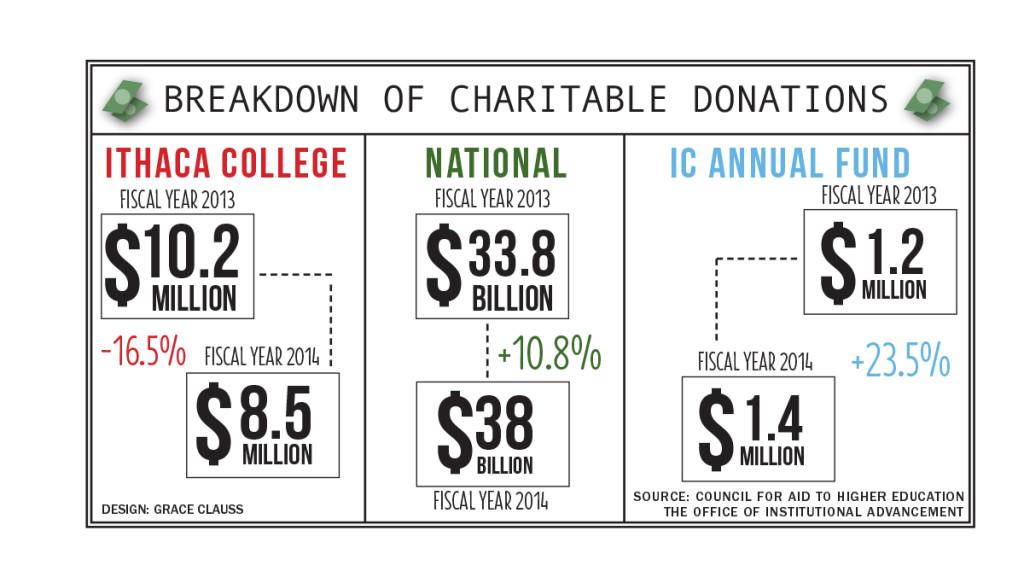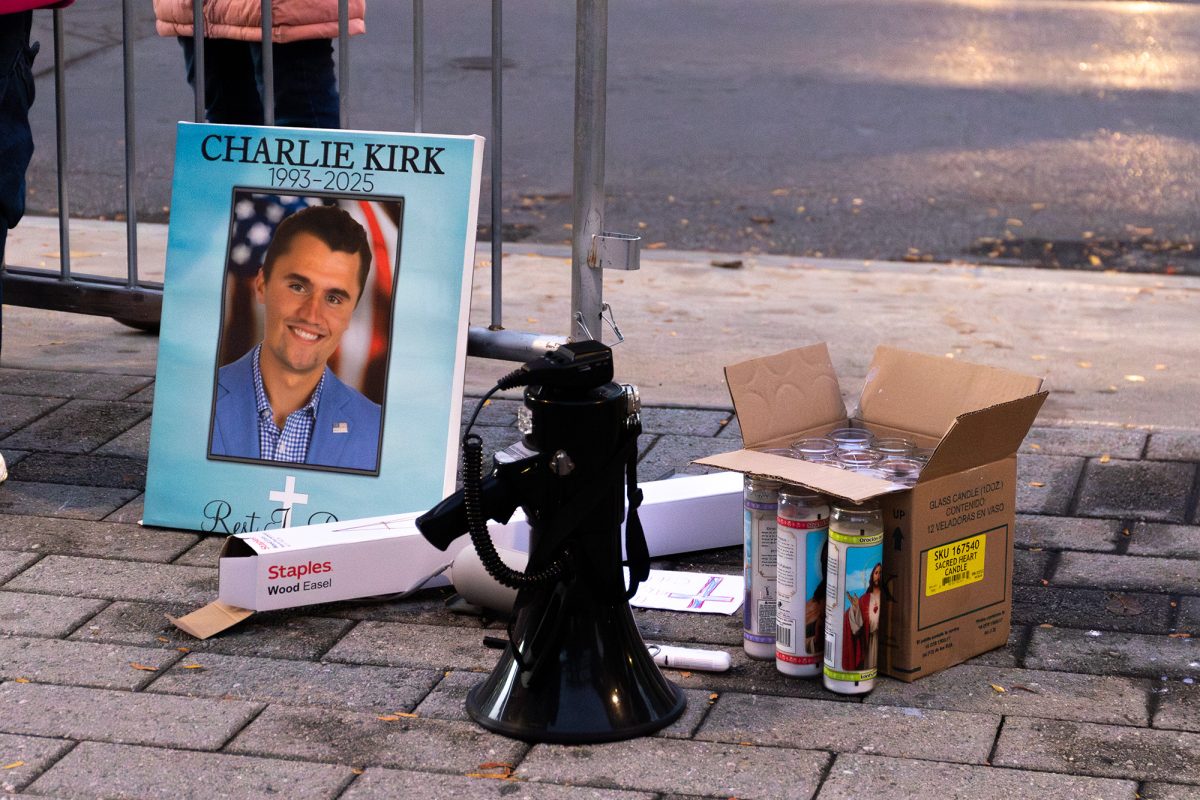As Ithaca College sees more alumni making charitable donations, the overall dollar amount of gifts has fallen from last year.
Total charitable donations to Ithaca College decreased in fiscal year 2014 while the number of alumni donors increased, according to a survey administered by the Council for Aid to Education.
The Voluntary Support of Education survey is an annual study of fundraising by colleges and universities. The number of alumni donors increased by 3.7 percent from 4,793 in fiscal year 2013 to 4,969 in fiscal year 2014. At the same time, overall donations decreased from $10,152,873 to $8,479,102, a 16.5-percent decline. However, donations specifically to the Ithaca College Annual Fund, the money that supports campus services, reached $1.4 million in fiscal year 2014, an increase of $272,547 over fiscal year 2013, setting a new record.
Ann Kaplan, director of the Voluntary Support of Education survey conducted by the Council for Financial Aid to Education, said 1,019 institutions, including Ithaca College, participated in the survey, which examined the total gifts versus alumni gifts donated as well alumni participation.
Two large gifts in 2013, totaling $3.04 million, contributed to a 20.4-percent increase in total donations that year. Without two similar gifts again, the college experienced a decrease in donations this year, Kaplan said.
“There were two large personal gifts to Ithaca in 2013, which contributed to a spike in that year and a decline, therefore, this year,” Kaplan said.
Stephen Savage, associate vice president in the Office of Institutional Advancement, said the fiscal year 2014 was a positive year despite the lower overall totals.
“When you look at the overall dollars it was down, but we expected it to be down,” Savage said. “We have been in the process of revitalizing our advancement operation and laying the groundwork for a much more productive and successful operation long term.”
Savage said the college had hoped to receive contributions from a few major donors this year that did not materialize because it takes longer to work out the details of large gifts.
“We have been in conversation with some major donors that we had anticipated would be finalized in fiscal year 2014, but that just didn’t happen, for a variety of reasons, which is not that uncommon,” Savage said. “Some of them have been given during the current [2015] fiscal year. We are currently over 50 percent ahead of dollars raised for fiscal year 2015, which can be attributed to gifts from these donors and others.”
Savage said he is most excited by the success of the Annual Fund, which raised $1.4 million from 7,980 donors. This was a $272,547 increase over last year, or a 2.6-percent increase. Donations to the Annual Fund are considered gifts to the college as a whole, Savage said, describing the fund as a flexible stream of revenue that offsets the gap between tuition and the Ithaca College experience.
“The success of the Annual Fund is the big headline,” Savage said. “Only a few years ago we were raising $850,00 annually. Now we are at $1.4 million and expect to raise $1.5 million this year.”
The percentage of alumni participating has decreased in the past 10 years, following a national trend. This decrease is due to a greater number of alumni of record per student, Kaplan said. She said the number of alumni of record per student compares the number of accurate addresses of alumni a school has compared to the number of students enrolled. The number of alumni of record per student is 11 at the college, greater than the national average of eight.
The percent of alumni participation decreases when colleges improve alumni records, which has been made easier by more advanced technology. While the college’s alumni participation increased from 6.9 percent in 2013 to 7 percent in 2014, it has decreased dramatically from 14.4 percent in 2004.
“The institution can be making a real push to find lost alumni and the more they find, the lower their percentage will be,” Kaplan said. “But it’s good for them to keep having more and more records. In that way Ithaca is doing better than average.”
The 2015 Senior Class Gift Committee established a goal of having 560 senior class donors, which is 40 percent of the class, co-chair Hannah Oppenheim said. The monetary goal this year is $10,640, and the IC Alumni Association Board of Directors will donate $75 per senior who contributes. Students donating to the senior class gift campaign can choose to direct their gift to the Annual Fund or to a specific school or program, Oppenheim said.
“Seniors can allocate their gift to where it matters most to them, but the IC Annual Fund supports students across campus and has the greatest impact,” Oppenheim said. “By giving to the Annual Fund, you are giving future students the opportunity to create their own unique IC experience, just as you did.”
The 2014 Senior Class Gift Campaign raised $10,889 in donations from 598 donors, which was 37.4 percent of their senior class.
Rob de la Fuente, director of the Annual Fund, said senior class participation declined in 2014, but was still the third-highest participation rate ever. The record for participation was set in 2013 with 38.8 percent of the senior class making contributions.
“It’s impossible to guarantee, but given the trajectory that 2015 is taking I suspect they will set a new record,” de la Fuente said.
Senior Ayesha Patel, who donated to the 2015 Senior Class Gift Campaign, said she believes it is important for students to consider their financial situation as well as their experiences at the college when deciding to contribute a gift.
“For me, in the end it was remembering that the money I contribute could help a student have an experience that otherwise might not be there,” Patel said. “I’ve had a great four years at Ithaca College filled with experiences that I know were in part made possible by donors, and I wanted to continue the cycle and contribute what I could to a current or future student’s time at IC.”
Savage said rebranding the Annual Fund as the Ithaca College Annual Fund three years ago and more advanced soliciting techniques have led to the increase in donations.
“We have become much more sophisticated in how we solicit gifts to make it as personal as possible to resonate with the donor even more,” Savage said.
De la Fuente said 602 students donated a total of $11,287 in fiscal year 2014.
Savage stressed the importance of maintaining good relationships with the college’s donors.
“We have been focusing on our stewardship of our donors, so once you make the gift, we acknowledge it,” Savage said. “We are trying to do that in a much more timely fashion and a much more personable fashion, and I think that has an impact.”







